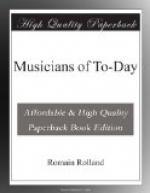[Footnote 131: “I like Liszt’s music so much, because he does not bother about other people’s opinions; he says what he wants to say; and the only thing that he troubles about is to say it as well as he possibly can” (Quoted by Hippeau).]
[Footnote 132: The quotations are taken from Harmonie et Melodie and Portraits et Souvenirs.]
[Footnote 133: In Harmonie et Melodie M. Saint-Saens tells us that he organised and directed a concert in the Theatre-Italien where only Liszt’s compositions were played. But all his efforts to make the French musical public appreciate Liszt were a failure.]
“People have not hesitated to scoff at what they call my weakness for Liszt’s works. But even if the feelings of affection and gratitude that he inspired in me did come like a prism and interpose themselves between my eyes and his face, I do not see anything greatly to be regretted in it.[134] I had not yet felt the charm of his personal fascination, I had neither heard nor seen him, and I did not owe him anything at all, when my interest was gripped in reading his first symphonic poems; and when later they pointed the way which was to lead to La Danse macabre, Le Rouet d’Omphale, and other works of the same nature, I am sure that my judgment was not biassed by any prejudice in his favour, and that I alone was responsible for what I did."[135]
[Footnote 134: The admiration was mutual. M. Saint-Saens even said that without Liszt he could not have written Samson et Dalila. “Not only did Liszt have Samson et Dalila performed at Weimar, but without him that work would never have come into being. My suggestions on the subject had met with such hostility that I had given up the idea of writing it; and all that existed were some illegible notes.... Then at Weimar one day I spoke to Liszt about it, and he said to me, quite trustingly and without having heard a note, ’Finish your work; I will have it performed here.’ The events of 1870 delayed its performance for several years.” (Revue Musicale, 8 November, 1901).]
[Footnote 135: Portraits et Souvenirs.]
This influence seems to me to explain some of M. Saint-Saens’ work. Not only is this influence evident in his symphonic poems—some of his best work—but it is to be found in his suites for orchestra, his fantasias, and his rhapsodies, where the descriptive and narrative element is strong. “Music should charm unaided,” said M. Saint-Saens; “but its effect is much finer when we use our imagination and let it flow in some particular channel, thus imaging the music. It is then that all the faculties of the soul are brought into play for the same end. What art gains from this is not greater beauty, but a wider field for its scope—that is, a greater variety of form and a larger liberty."[136]
* * * * *




